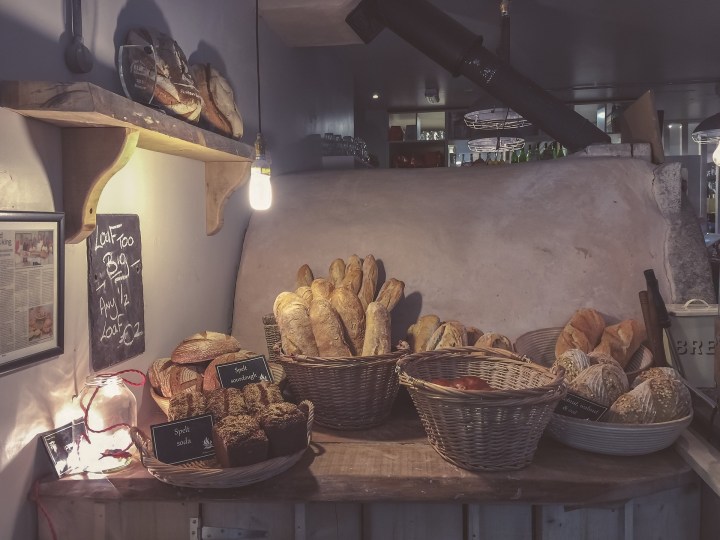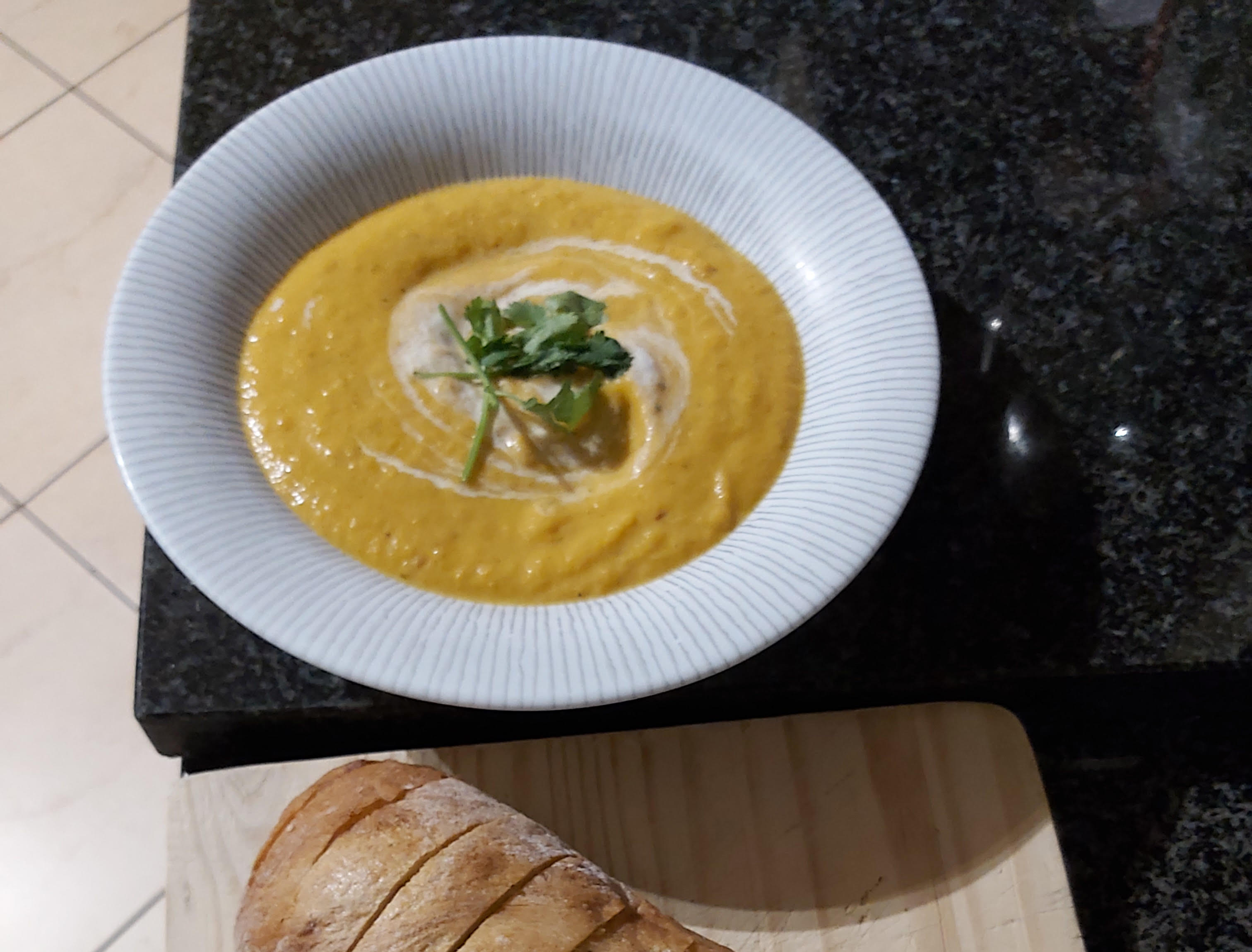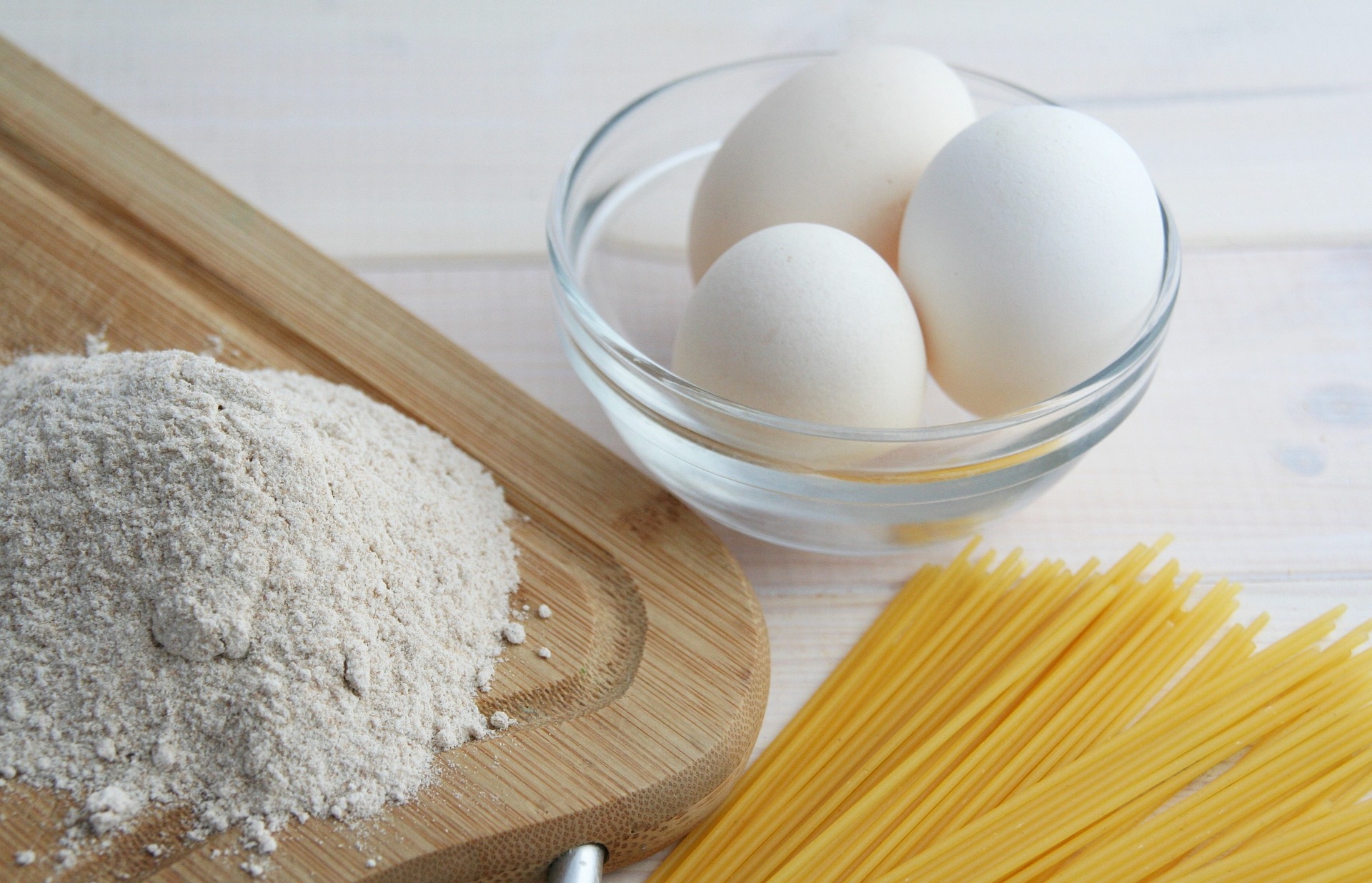ISOLATION BAKING 0.2
Maverick Insiders get creative and turn to the basics

Daily Maverick’s Insiders were asked to send us their recipes to make while in isolation. We have Empty Shelves Carrot and Coriander Soup, Rise and Fall Seeded Breadsticks and Two-Ingredient Pasta.
Empty Shelves Carrot and Coriander Soup
By Insider: Nicci Richardson

Insider Nicci Richardson’s ‘Empty Shelves’ Carrot and Coriander Soup. Photo: Supplied
This week I made my dash to market wearing a mask and gloves. Initially, it was just the mask that was a challenge because it caused my glasses to steam up making sight, let alone any shopping, a challenge…and then I found pretty much empty shelves.
So, confronted with my list and no fresh veg that was actually on it available, I grasped what was and created my own recipes…one of which is the Carrot and Coriander soup I made for dinner. The quantities are not exact and my recipes always adapt to what I have on hand (hence the addition of chilli flakes and paprika as I felt it just needed a little oompf) so I’ll leave it up to everyone to add more or less of what they’d prefer.
Ingredients
3kg bag of carrots, peeled
250g medium potatoes, peeled
500g sweet potatoes, peeled
250g creme fraiche
2l chicken or vegetable stock
50g fresh coriander
15ml fresh ginger
15ml fresh garlic
5ml red chilli flakes
2.5ml smoked paprika
salt and pepper to taste
Method
Don’t bother to chop the veggies into small pieces, peeling is enough work and it all gets blended anyway. Just keep the veggies roughly the same size so they cook evenly. Mix everything into a large pot except for the creme fraiche which is done off the heat at the end.
When the veggies are cooked but not mushy (don’t lose the flavour by overcooking), blend the soup using a stick blender. Mix through the creme fraiche and serve with a sprig of coriander and swirl of creme fraiche. We love the soup with either croutons or crusty bread.
This made a huge pot (probably enough for 6-8 people) so great for the freezer
Rise and Fall Seeded Breadstick
By Insider: Steve Kirk-Cohen

Too hungry to wait, Insider Steve Kirk-Cohen made Seeded Breadsticks and a Corna Kugel. Photo: Supplied
I visited your Isolation Baking with great glee and saw (and tried) Anne Kellner’s Sweet Potato Bake. Midway through it, my mind was cast back to a cookbook I have not opened for decades, vegetarian recipes from the Moosewood Collective, and the unforgettable Mollie Katzen.
Those of us who have a “Cohen” in our surname should be ashamed for not realising immediately that this recipe (delicious it was, and thanks to Anne) falls full square into the baked dishes known as kugels. Yes, the primary meaning of the word (historically, at least) was food. The recipe sent me scuttling for my old and dusty copy of The Enchanted Broccoli Forest which is now available ﹣ I see ﹣ in an updated version.
Spurred on to contribute to the Isolation Baking initiative, I scratched my head a bit. What is it that we can do in isolation? Then the answer hit me: South Africans must bake bread! And I know that because for days I was scavenging the shelves looking for my favourite Eureka flour to keep myself in bread in isolation. Largely in vain did I search …. the shelves of all grocers and supermarkets I visited were stripped of all flour. So much for being choosy about Eureka, there was nothing, nada, zip. Not even the cottonwool refined-out-of-existence flours I turn my nose up at. You know the ones: when the weevils have eaten everything else in your store cupboard these will remain pristine, unmolested and un-weeviled. Eventually, a deli took mercy on me and hauled some Eureka out from under the counter, and I was in business.
So, to everyone who has snaffled up my favourite flour and is now wondering what to do with it, here is something different from just another loaf of bread.
You can do it with brown flour, cake flour, white bread flour. You can do it with dry yeast from a sachet, wet yeast (remember that stuff?) or you can make it with a mother yeast for those of us that like sourdough and who keep Mother Theresa ticking over in the fridge week after week, month after month, and year after year for three years now.
It is a seeded breadstick. You need about 950g of bread dough, however you make it. But one qualification from a fussy breadmaker: you need 65% dough.
Before your eyes glaze over, dear reader, bear with me for a little baking science. Baking is best approached on the basis that everything is weighed, not measured in ML. That is not so important eg. for the teaspoon or two of yeast that you are used to, or the tablespoon of salt. But when it comes to flour and water, it is the answer to baking. A 65% dough will regard the flour weight at 100%, and the water addition must be 65% of that.
You don’t need to throw your tried-and-tested bread recipe out of the window. Far from it. If the flour is measured in grams, you are away and baking. If it is not: measure out the flour the way you usually do, and then pop it on a scale and weigh it. The water addition will then be 65% of this weight. For example: if the flour weighs 600g, the sum is 600 x 0.65 = 390. The water to add to the flour will be 390 grams. Weigh it too and: Viola! he says (his French not being what it should be).
Make a batch of 65% dough and leave it to rise as you normally do. While you are doing this, scavenge around in your store cupboard for some seeds. Any seeds will do: sesame, linseed, sunflower, pumpkin. Get a big handful or two of mixed seeds, and weigh them. Remember the weight, and divide by five. Then look around for some coarse salt. If you don’t have any immediately to hand, think about raiding your salt grinder. Depending on the coarseness you may have to make small pieces out of big pieces of salt by subjecting them to a mortar and pestle treatment.
Mix the salt with the seeds and put them on a baking tray. Flour up another baking pan and have it on standby.
When your dough is ready, give it a final knead. Then do the impossible: try to coax it into a rectangular shape with a rolling pin, and don’t roll it too thin. You want to cut it into strips which are about 3cm wide and still 1cm thick. If you roll it too thin, knead it and start again. It must be thick. If you can get anything remotely resembling a rectangle, be happy and well done.
Arm yourself with a cutting implement (dough paddle or knife, but don’t use the Wusthof) and cut it into 3cm wide strips. Dampen the top surface with water (use your finger or a brush) but do so sparingly; you don’t want water sloshing on your work surface at this (or any) stage.
Now, carefully lift up the dough strip﹣don’t let it stretch ﹣ and dump it wet-side down onto the seeds and salt. When the seed and salt mixture have adhered, lift it up carefully again, and dump it seed-side down onto the floured baking tray. Dust the upper surface of each strip with flour.
Keep going until you have breadsticks. A normal kilogram of dough should yield about 6 of these sticks and leave you with enough dough left over to make a bread roll or two.
Cover the strips with a slightly damp cloth to stop them drying out.
Turn on the oven to 250℃. To quote a Danish baker-friend of mine: “Don’t spare ze hammers”. Hotter than 250℃ is also OK. In anticipation of fast action later, put a pan of sorts at the bottom of the oven; anything cast iron will do well.
After about 15 minutes comes the tricky part. You need to twist these strips around. Save the seeds and salt from the first baking tray then flour it up. Working from the middle (and leaving the dough strip on the tray, don’t make the mistake of picking up an end) twist it around as gently and consistently as possible, working from the middle to one end, and then from the middle to the other end. The ends have a tendency to want to get thin and you need to be careful to try to keep the thickness the same throughout. When each one is twisted, lift it off the pan onto the freshly floured other pan. Leave some rising space between them; you may have to bake in batches to achieve this. Cover them with a towel again and leave them at least 15 minutes more, or until your oven hits 250℃, whichever happens later.
Get a jug with 250ml of boiling water in it. This bread likes to bake in a humid oven and this will be poured into the pan at the bottom of the oven just before you close the door.
Slip the baking tray into the oven, exercising extreme caution, pour the hot water into the tray at the bottom of the oven, and close the door before you lose too much heat.
Set the timer. Depending on the thickness of the sticks they will take 12 to 15 minutes.
If you want baking precision, get a meat thermometer and ﹣ after the baking time ﹣ put the probe of the thermometer into the thickest part of the bread. Less than 95℃, and the sticks need to go back in for a minute or two. 98℃ and above, they are done. Significantly more than 98℃: overdone. Make a mental note to reduce the cooking time next time.
Don’t waste the heat ﹣ turn the oven down to 180℃. Put in the Corna Kugel and let it bake for 50 minutes. Or did I forget to tell you to get the kugel ready while you did this? Anyway, that is the way I did it.
Tired and hungry, I forgot to take a photo of the kugel before we tucked in. I did remember to take one afterwards; see attached with breadstick on the side.
Good luck, fellow bakers.
Two-Ingredient Homemade Pasta
Insider: Paolo Lupini

Image by Joanna Dubaj from Pixabay
Ingredients
100 grams of any flour plus one egg per serving
Method
It is better to sieve the flour, maybe even twice, to lighten it for mixing, unless you get imported or double-sieved flour.
Mix egg and flour by hand in a bowl first, then on a flour-covered table or machine thoroughly until silky and make into a ball. After about 15 minutes of kneading place dough ball in the fridge wrapped in plastic for half an hour.
Cut dough ball into one-inch slices and, on a flour-covered table, use a rolling pin (or clean wine bottle!) to roll it as thin as you can. Use a sharp knife to cut strips and voila, you have delicious homemade pasta.
Cook for 3-4 minutes in hot, lightly salted and slightly oily water. Use any sauce you want and enjoy with red wine and grated cheese! DM
Insiders shared their first batch of recipes to make during lockdown on 27 March, including No-Knead Easy Fridge Bread, ‘X Factor’ Baked Beans, ‘This is Not a Risotto’ and the morbidly delicious Chocolate Depression Cake. Send your Isolation Baking/ Cooking recipes, with a hi-resolution photograph, to: [email protected]



 Become an Insider
Become an Insider